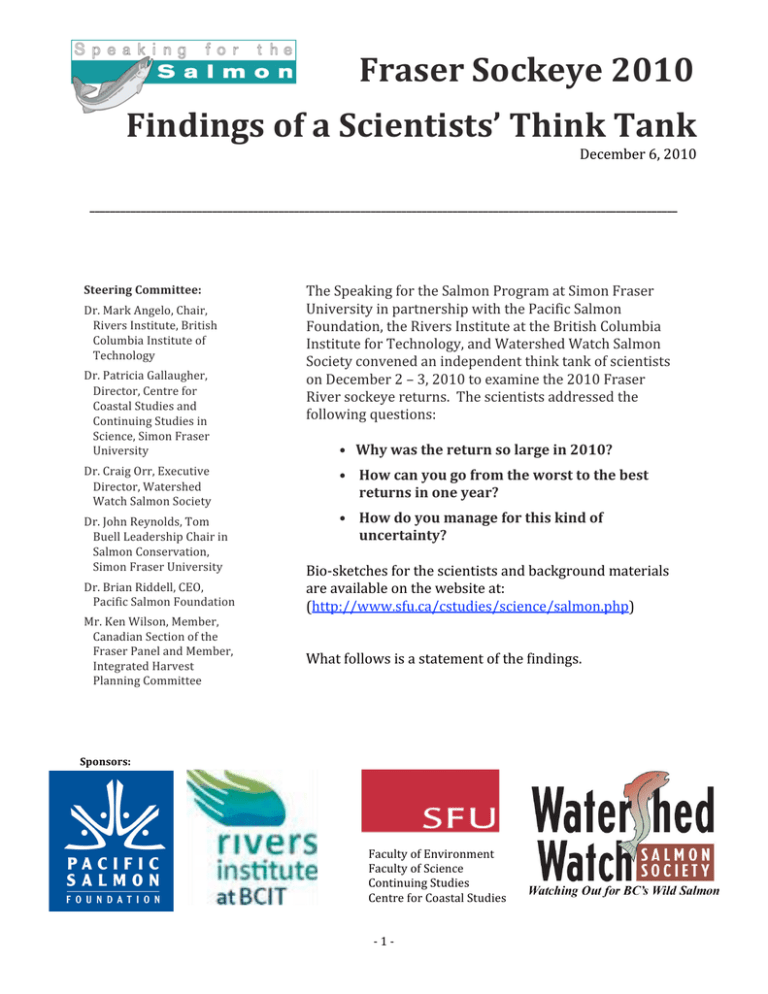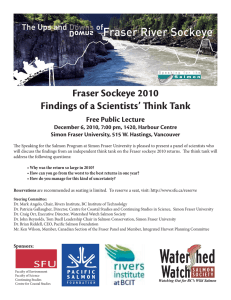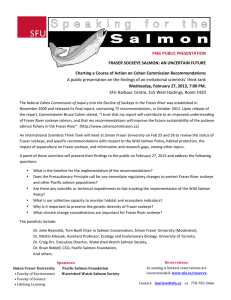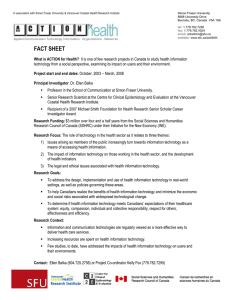Fraser Sockeye 2010 Findings of a Scientists’ Think Tank December 6, 2010
advertisement

Fraser Sockeye 2010 Findings of a Scientists’ Think Tank December 6, 2010 ___________________________________________________________________________________________________________________ Steering Committee: The Speaking for the Salmon Program at Simon Fraser University in partnership with the Pacific Salmon Dr. Mark Angelo, Chair, Rivers Institute, British Foundation, the Rivers Institute at the British Columbia Columbia Institute of Institute for Technology, and Watershed Watch Salmon Technology Society convened an independent think tank of scientists Dr. Patricia Gallaugher, on December 2 – 3, 2010 to examine the 2010 Fraser Director, Centre for River sockeye returns. The scientists addressed the Coastal Studies and following questions: Continuing Studies in Science, Simon Fraser University • Why was the return so large in 2010? Dr. Craig Orr, Executive • How can you go from the worst to the best Director, Watershed returns in one year? Watch Salmon Society • How do you manage for this kind of Dr. John Reynolds, Tom uncertainty? Buell Leadership Chair in Salmon Conservation, Simon Fraser University Bio‐sketches for the scientists and background materials Dr. Brian Riddell, CEO, are available on the website at: Pacific Salmon Foundation (http://www.sfu.ca/cstudies/science/salmon.php) Mr. Ken Wilson, Member, Canadian Section of the Fraser Panel and Member, What follows is a statement of the findings. Integrated Harvest Planning Committee Sponsors: Faculty of Environment Faculty of Science Continuing Studies Centre for Coastal Studies ‐ 1 ‐ STATEMENT OF FINDINGS What happened in 2010? About 29 million Fraser River sockeye salmon returned to the coast this year. This was the largest return since 1913, and well above the 11 million that had been forecast. This high return was in strong contrast to the trend since the early 1990s of declining productivity in the Fraser, culminating in only 1.5 million Fraser sockeye returning last year. This sudden reversal of fortunes has led to questions about science and management, which were the subject of a Think Tank involving 23 scientists hosted by Simon Fraser University on December 2nd and 3rd, 2010. Although the aggregate return of Fraser sockeye was very large, when considering the individual populations that comprise the Fraser complex, the picture is somewhat mixed. While returns were higher than forecasts for most stocks, the strong aggregate return was driven largely by fish from the Adams River, which has high runs every four years, including 2010. There were also stronger than average returns of fish to the Harrison and Chilko Rivers, which, like the Adams, are in the lower to middle part of the watershed. In contrast, returns were still below average for populations in the upper watershed, such as the Early Stuart complex that spawns in areas around Takla and Stuart lakes northwest of Prince George. Thus, while the aggregate returns to the Fraser watershed were indeed exceptionally high, this was only true for a subset of tributaries. The Fraser watershed was not full of fish. Most of the fish that returned this year were produced by adults that spawned in 2006. In that year, continuing low returns had led to reductions in the fishery in order to protect the spawning population. The reduced fisheries in 2006 succeeded in allowing the 6th largest number of fish to reach the spawning grounds since 1952 and possibly since the Hells Gate slide in 1913. This large number of spawners four years ago was one reason for the large number of fish that returned in 2010. A second contributing factor for the large returns this year was a change in coastal ocean conditions toward cool temperatures in early 2008, when the fish that returned this year were juveniles entering the sea. These temperatures were similar to those occurring in the 1970s. Cool temperatures support food webs, including energy‐rich zooplankton, that are favourable to growth and survival of juvenile sockeye salmon. A third possible contributing factor was the occurrence of a major volcanic eruption in Alaska’s Aleutian Islands in early August of 2008, which spread ash over much of the offshore Gulf of Alaska. This ash fertilized the ocean and triggered an algal bloom in the region that the Fraser River sockeye migrate to. This algal bloom was too late in the summer to trigger a population increase in zooplankton (food for salmon), but it may have increased the caloric value and availability of those zooplankton and enhanced over‐winter survival. Support for the volcano theory to explain the large returns in 2010 remains equivocal at this stage. Overall, 2010 represented a return to the historical average of productivity (returns/spawner) experienced in the 1970s. It remains to be seen whether the favourable ocean conditions are a one‐time event or mark a return to more favourable conditions from the past. Unfortunately, in the absence of adequate information on pathogens and parasites on salmon farms along the ‐ 2 ‐ migration route, the role of this potential factor in both the recent declines in marine survival and in the remarkable turnaround in 2010 cannot be assessed. Mortality of fish during their upstream migration and prior to spawning has been an ongoing concern in the Fraser. This can be exacerbated by a tendency since 1996 of fish that comprise the “late‐run” complex, including those from the Lower Adams River, to migrate up‐river earlier than usual, thereby encountering much higher temperatures than average during their migration. This early migration of a segment of late‐run fish occurred again in 2010. While the temperatures in 2010 were not as extreme as has been seen in several of the past 15 years, temperatures in the lower Fraser River exceeded 180 C for a 30‐day period in mid summer, a thermal duration known to reduce survival of migrating adults. These temperatures serve as a reminder of the growing challenges that Fraser salmon will continue to face as a result of climate change. What can we learn from 2010 about science and management? One lesson from 2010 is that conservation efforts to allow fish from the parental generation to reach the spawning grounds can work. While this is certainly encouraging, we were also lucky, due to the reversal of oceanic conditions to cooler temperatures not seen since the 1970s. Second, the high returns of 2010 also underscore how difficult it is to track (and forecast) a moving target, whereby salmon live or die according to an enormous number of interacting variables during both the freshwater and marine phases of their life cycles. We should expect surprises because of the complexity of ecological interactions and the inherent unpredictability of the weather and ocean conditions that drive them. Third, the high return reminded us how important it is for managers to have access to accurate in‐season information as the salmon are returning to the coast, given the inherent uncertainties in forecasts. Moving forward Canada’s Wild Salmon Policy sets clear priorities for management of salmon. However, implementation of this policy has been slow. The Department of Fisheries and Oceans needs to demonstrate the will to convert the admirable intentions of the policy into meaningful management action. There will be important tradeoffs between objectives such as commercial‐ scale exploitation of strong stocks and protection of weak stocks. Implementation of the Policy should be accompanied by transparent analyses of the magnitudes of such fisheries tradeoffs, and consideration of the fuller set of values included in the Policy, including First Nations catches, ecosystem‐based management, protection of a diversity of populations, and social values. The large unresolved uncertainties about what caused the catastrophic return in 2009 and the unprecedented high return in 2010 highlight our collective uncertainty about the relative roles of climate change, aquaculture, and fisheries management in determining salmon returns. Efforts should be made to develop a coordinated multi‐disciplinary research program to address these issues. Partnerships should harness existing resources and studies, augmented by improved monitoring. There are few comprehensive year‐round, annual ecological studies of lake ecology in relation to salmon. We need to better understand ecological interactions in lakes, including any delayed competitive effects that may occur between young from successive cohorts. ‐ 3 ‐ Monitoring should proceed from lakes to the sea: there have been few comprehensive studies of out‐migrating Fraser sockeye smolts since the 1960s, yet recent research suggests that there may be higher mortality of fish at this phase of their life cycle than had been previously thought. This program should include an investigation of survivorship as far along the coastal migration routes as is feasible. The program should include factors that can influence survival, such as diseases, food availability, predators, and contaminants. This should include use of new technological innovations in electronic tagging of fish and sensory apparatus to monitor of their environment. This monitoring should be integrated with assessments of the health of fish in salmon farms, including retroactive and ongoing full public disclosure of comprehensive and rigorous monitoring programs for pathogens and parasites in fish farms. Finally, we need to maintain and improve in‐season stock assessments through test fisheries and other means, in order to gauge the strength of runs of returning fish earlier in the season than is currently possible, in order to give managers and the fishing industry more time to open fisheries when warranted. Scientists who participated in the Think Tank felt strongly that the enhanced monitoring programs recommended above will greatly improve our ability to sustain populations of Fraser River sockeye in a changing world. Catch and escapement of Fraser sockeye 35 Millions 30 25 20 15 Escapement Catch 10 5 0 Year These data were provided by the Pacific Salmon Commission (PSC). Spawning escapements in 2010 are preliminary estimates generated by the Think Tank of scientists, using data from the Mission hydroacoustic site. The estimates of escapement for 2010 will undoubtedly change when the Department of Fisheries and Oceans generates final numbers in early 2011. ‐ 4 ‐ The figure above shows returns per spawner, which is the total number of adults produced by each spawner. This includes catch, in‐river mortality, and fish that survive to spawn. The productivity figure presented in the statement of the Scientists’ Think Tank from 2009 used four‐ year averaged running productivity, to smooth out spikes caused by annual variation in productivity by some strongly cyclical stocks. The figure presented above shows actual year‐by‐ year values, without the four‐year averaging. The figure above presents four‐year running average productivity comparable to the figure that was produced by the 2009 Scientists’ Think Tank. Although the returns per spawner in 2010 were near average, the value is brought down by the three preceding years of low productivity. ‐ 5 ‐ Think Tank of Scientists List of Participants (bio sketches available at http://www.sfu.ca/cstudies/sciencee/salmon.php) December 2010 ___________________________________________________________________________________________________________________ Dr. Mark Angelo Chair, Rivers Institute, British Columbia Institute of Technology Dr. Sonia Batten Pacific CPR Project Coordinator, Sir Alister Hardy Foundation for Ocean Science Dr. Doug Eggers Chief Fisheries Scientist, Alaska Department of Fish and Game Dr. Ian Fleming Professor, Ocean Sciences Centre, Memorial University of Newfoundland Dr. Patricia Gallaugher Director, Continuing Studies in Science and the Centre for Coastal Studies; and Adjunct Professor, Biosciences, Simon Fraser University Dr. Kees Groot Scientist Emertius, DFO and Consultant, Yellow Point Bio‐Research Dr. Scott Hinch Fisheries Scientist, Forest Sciences and Centre for Applied Conservation Research, University of British Columbia Dr. Nathan Mantua Associate Professor, School of Aquatic and Fishery Sciences, University of Washington; and Research Scientist, PNW Station, US Forest Service Dr. Catherine Michielsens Quantitative Fisheries Biologist, Pacific Salmon Commission Dr. Jonathan Moore Assistant Professor and Liber Ero Chair of Coastal Studies, Simon Fraser University (January 2011) Dr. Alexandra Morton Director, Salmon Coast Field Station Dr. Craig Orr Executive Director, Watershed Watch Salmon Society Dr. Randall M. Peterman Professor, School of Resource and Environmental Management, Simon Fraser University Dr. John Reynolds Professor, Biological Sciences and Tom Buell BC Leadership Chair in Salmon Conservation and Management, Simon Fraser University Dr. Brian Riddell CEO and President, Pacific Salmon Foundation Dr. Marvin Rosenau Instructor, Fish, Wildlife and Recreation Program, British Columbia Institute of Technology Dr. Rick Routledge Professor, Statistics and Actuarial Sciences and Co‐ Director, Hakai Network for Coastal People, Ecosystems and Management, Simon Fraser University Michael Staley Senior Biologist, Fraser River Aboriginal Fisheries Secretariat and Member, Fraser River Panel Technical Committee Dr. Jack Stanford Jessie M. Bierman Professor of Ecology and Director, Flathead Lake Biological Station, University of Montana Dr. Carl Walters Professor, Fisheries Centre, University of British Columbia Dr. David Welch President, Kintama Research Corporation Ken Wilson Member, Marine Conservation Caucus, Integrated Harvest Planning Committee; and Member, Canadian Caucus of the Fraser Panel, Pacific Salmon Commission Dr. Andrew Wright Director of Actenum, Zymeworks, and Pharos Capital and a co‐founder of Aegis Mobility ‐ 6 ‐




